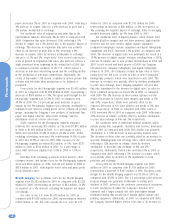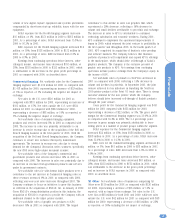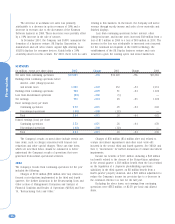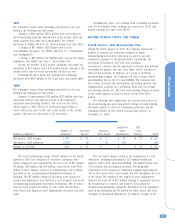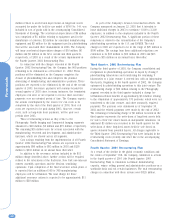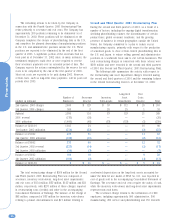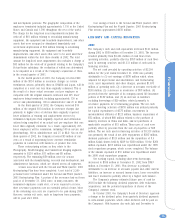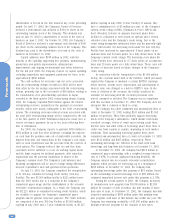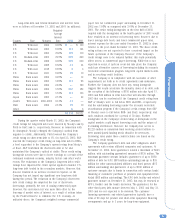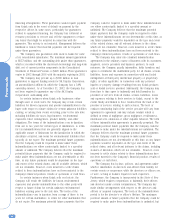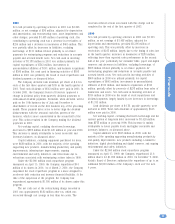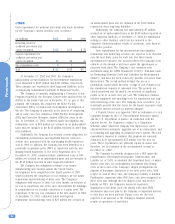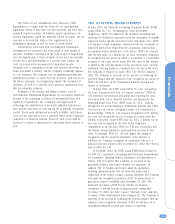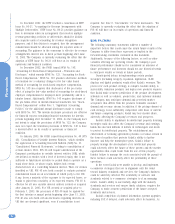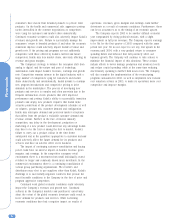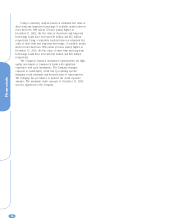Kodak 2002 Annual Report Download - page 28
Download and view the complete annual report
Please find page 28 of the 2002 Kodak annual report below. You can navigate through the pages in the report by either clicking on the pages listed below, or by using the keyword search tool below to find specific information within the annual report.
Financials
28
financing arrangements. These guarantees would require payment
from Kodak only in the event of default on payment by the
respective debtor. In some cases, particularly for guarantees
related to equipment financing, the Company has collateral or
recourse provisions to recover and sell the equipment to reduce
any losses that might be incurred in connection with the
guarantee. This activity is not material. Management believes the
likelihood is remote that material payments will be required
under these guarantees.
The Company also guarantees debt owed to banks for some
of its consolidated subsidiaries. The maximum amount guaranteed
is $857 million, and the outstanding debt under those guarantees,
which is recorded within the short-term borrowings and long-term
debt, net of current portion components in the Consolidated
Statement of Financial Position, is $628 million. These guarantees
expire in 2003 through 2005 with the majority expiring in 2003.
The Company may provide up to $100 million in loan
guarantees to support funding needs for SK Display Corporation,
an unconsolidated affiliate in which the Company has a 34%
ownership interest. As of December 31, 2002, the Company has
not been required to guarantee any of the SK Display
Corporation’s outstanding debt.
In certain instances when Kodak sells businesses either
through asset or stock sales, the Company may retain certain
liabilities for known exposures and provide indemnification to the
buyer with respect to future claims for certain unknown liabilities
existing, or arising from events occurring, prior to the sale date,
including liabilities for taxes, legal matters, environmental
exposures, labor contingencies, product liability, and other
obligations. The terms of the indemnifications vary in duration,
from one to two years for certain types of indemnities, to terms
for tax indemnifications that are generally aligned to the
applicable statute of limitations for the jurisdiction in which the
divestiture occurred, and terms for environmental liabilities that
typically do not expire. The maximum potential future payments
that the Company could be required to make under these
indemnifications are either contractually limited to a specified
amount or unlimited. The Company believes that the maximum
potential future payments that the Company could be required to
make under these indemnifications are not determinable at this
time, as any future payments would be dependent on the type
and extent of the related claims, and all available defenses, which
are not estimable. However, costs incurred to settle claims
related to these indemnifications have not been material to the
Company’s financial position, results of operations or cash flows.
In certain instances when Kodak sells real estate, the
Company will retain the liabilities for known environmental
exposures and provide indemnification to the other party with
respect to future claims for certain unknown environmental
liabilities existing prior to the sale date. The terms of the
indemnifications vary in duration, from a range of three to ten
years for certain indemnities, to terms for other indemnities that
do not expire. The maximum potential future payments that the
Company could be required to make under these indemnifications
are either contractually limited to a specified amount or
unlimited. The Company believes that the maximum potential
future payments that the Company could be required to make
under these indemnifications are not determinable at this time, as
any future payments would be dependent on the type and extent
of the related claims, and all relevant defenses to the claims,
which are not estimable. However, costs incurred to settle claims
related to these indemnifications have not been material to the
Company’s financial position, results of operations or cash flows.
The Company may enter into standard indemnification
agreements in the ordinary course of business with its customers,
suppliers, service providers and business partners. In such
instances, the Company usually indemnifies, holds harmless and
agrees to reimburse the indemnified party for all claims, actions,
liabilities, losses and expenses in connection with any Kodak
infringement of third party intellectual property or proprietary
rights, or when applicable, in connection with any personal
injuries or property damage resulting from any Kodak products
sold or Kodak services provided. Additionally, the Company may
from time to time agree to indemnify and hold harmless its
providers of services from all claims, actions, liabilities, losses
and expenses relating to their services to Kodak, except to the
extent finally determined to have resulted from the fault of the
provider of services relating to such services. The level of
conduct constituting fault of the service provider will vary from
agreement to agreement and may include conduct which is
defined in terms of negligence, gross negligence, recklessness,
intentional acts, omissions or other culpable behavior. The term
of these indemnification agreements is generally perpetual. The
maximum potential future payments that the Company could be
required to make under the indemnifications are unlimited. The
Company believes that the maximum potential future payments
that the Company could be required to make under these
indemnifications are not determinable at this time, as any future
payments would be dependent on the type and extent of the
related claims, and all relevant defenses to the claims, including
statutes of limitation, which are not estimable. However, costs
incurred to settle claims related to these indemnifications have
not been material to the Company’s financial position, results of
operations or cash flows.
The Company has by-laws, policies, and agreements under
which it indemnifies its directors and officers from liability for
certain events or occurrences while the directors or officers are,
or were, serving at Kodak’s request in such capacities.
Furthermore, the Company is incorporated in the State of New
Jersey, which requires corporations to indemnify their officers
and directors under certain circumstances. The Company has
made similar arrangements with respect to the directors and
officers of acquired companies. The term of the indemnification
period is for the director’s or officer’s lifetime. The maximum
potential amount of future payments that the Company could be
required to make under these indemnifications is unlimited, but


